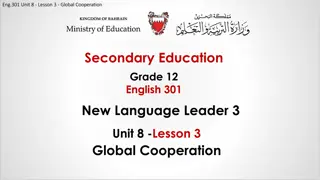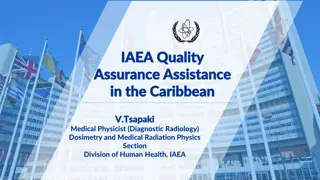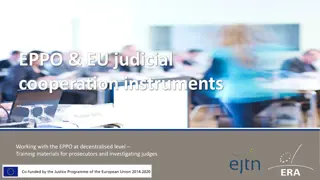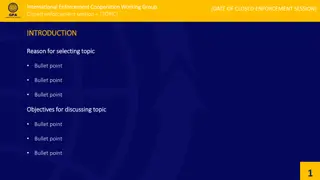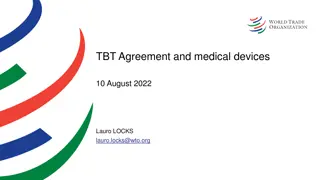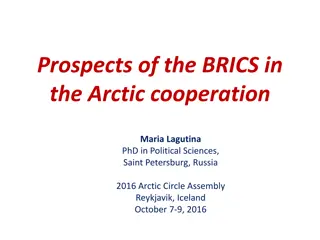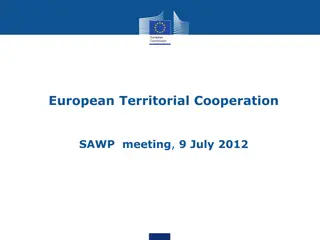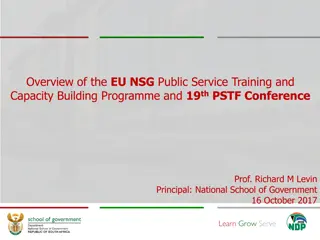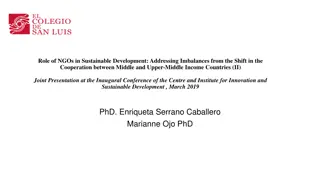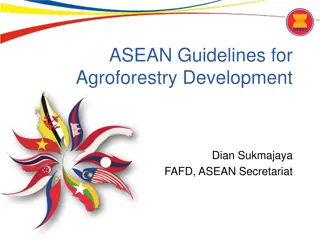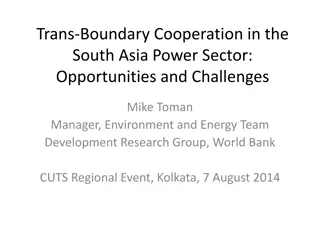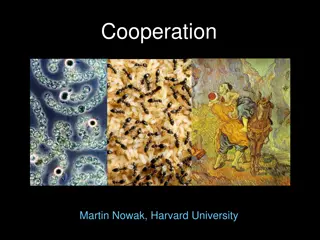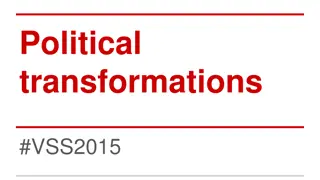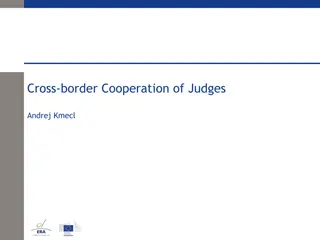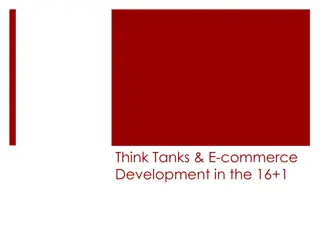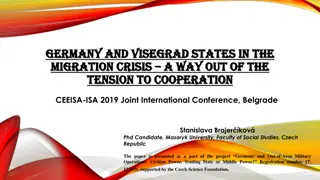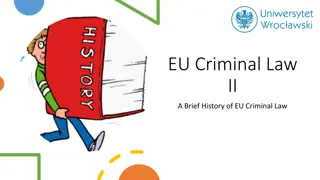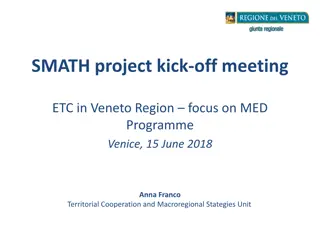History and Evolution of Visegrad Cooperation
The Visegrad Group's cooperation traces back to the tensions easing between East and West in the late 1980s, leading to the establishment of regional cooperation initiatives among Central European countries. The group's journey includes key milestones such as the dissolution of the Warsaw Pact, the formation of the Visegrad Declaration, and the establishment of the International Visegrad Fund. Despite some slowdowns, efforts towards Euro-Atlantic integration and revitalization of cooperation continue to shape the Visegrad Group's path.
Download Presentation

Please find below an Image/Link to download the presentation.
The content on the website is provided AS IS for your information and personal use only. It may not be sold, licensed, or shared on other websites without obtaining consent from the author.If you encounter any issues during the download, it is possible that the publisher has removed the file from their server.
You are allowed to download the files provided on this website for personal or commercial use, subject to the condition that they are used lawfully. All files are the property of their respective owners.
The content on the website is provided AS IS for your information and personal use only. It may not be sold, licensed, or shared on other websites without obtaining consent from the author.
E N D
Presentation Transcript
Visegrad: cooperation, fund and study 13th Visegrad Summer School Cracow 11 July 2014
The Path to Visegrd 1986 1990: Tensions ease between the East and West, Cold War coming to an end; increasing demand for a direct, regional cooperation between some countries Quadragonale established between Austria, Hungary, Yugoslavia, and Italy*, + Czechoslovakia (CS) = Pentagonale (1990), + Poland (PL) = Hexagonale (1992); later transformed into current Central European Initiative** (18 members) Bratislava Meeting initiated by V. Havel: CS + HU + PL (+ YU, IT, AT) 1989: 1990: http://www.visegradgroup.eu/about/history 2
The Path to Visegrd 1989: December - first of regular meetings of CS + HU + PL ministers of foreign affairs: How the three countries could support each other in dismantling the Soviet empire, transforming our countries politically and economically, and integrating with the institutions of the developed world? The first success in the cooperation departure of Soviet troops, dissolution of the Warsaw Pact (1991) led to the formalization of the cooperation J. Antall suggests (OSCE Paris) a follow-up to Bratislava Meeting to take place in Visegr d* J. Dienstbier 1990: Nov. 1990: http://www.visegradgroup.eu/about/history 3
The Path to Visegrd Jan. 21, 1991: CS, HU and PL MFAs decide to achieve the quickest dissolution of the Warsaw Pact and to work together to negotiate all association agreements with the European Community Feb. 15, 1991: Summit meeting of the troika (V3) in Budapest; later on, Visegrad Declaration signed in Visegr d Visegr d was selected by J. Antall as a symbolic re- connection to the royal peace and economic talks among Charlers Robert of Anjou, John of Luxembourg, and Casimir III in Visegr d in 1335/1336 http://www.visegradgroup.eu/documents/essays-articles/visegrad-1335 4
The Path to Visegrd Oct. 1991: May 1992: 1993 1998: Oct. 1998: May 1999: June 2000: 2nd V3 summit in Cracow 3rd (last) V3 summit in Prague (CS CZ + SK on Jan. 1, 1993) cooperation slows after the split of CS and due to the prevalence of individual efforts towards the Euro-Atlantic integration* Budapest Summit: PMs of CZ + HU + PL express support for revitalization of the cooperation Bratislava Summit (formal comeback): approval of Contents of Visegrad Cooperation International Visegrad Fund established ( ti n) http://www.visegradgroup.eu/about/cooperation 5
Visegrad Fund: Basic Characteristics V4 s only solid organization to date international organization accredited with SK MFA equal rights of V4 states: annual rotating presidency (January December) (presidencies in the group: July June) rotating management (3-year missions) consensus in decision-making equal contributions of V4 states ( 2M p.a.) external funding (NL, US, SE, CH ) 2-member management + 13-member staff (+ interns) www.visegradfund.org 6
The Funds Main Aims (financial) support of movement of people and ideas strengthening of the internal cohesion of the region weakening of historical animosities and awareness-building instrument of joint V4 foreign policy (since 2004): support of transfer of know-how from the region to the Western Balkans and Eastern Partnership countries (20% of overall funding in 2013) program priorities defined by the group (Strategic Grants, Visegrad+, V4EaP program chapter) key leverages: grant programs+ mobilities (scholarships, fellowships, artist residencies) www.visegradfund.org/about 7
Program Overview Academic and Mobility Programs Grant Programs Visegrad Scholarship Program: Intra-Visegrad, In-Coming, Out-Going Small Grants Standard Grants Visegrad Artist Residency Program (VARP): VARP Visual & Sound Arts VARP Performing Arts Visegrad Literary Residency Program VARP in New York Visegrad Strategic Grants Visegrad Strategic Conferences Visegrad+ (Western Balkans) Visegrad 4 Eastern Partnership Program: Flagship Projects V4EaP (Extended) Standard Grants V4EaP Visegrad University Studies Grants Visegrad University Studies Grants Visegrad Taiwan Scholarships Visegrad Scholarships at OSA IVF NSC Taiwan Joint Research Projects www.visegradfund.org/scholarships, /residencies www.visegradfund.org/grants 8
Grant Project Categories: Small/Standard Grants cultural cooperation (47%) scientific exchange and research (20%) education (15%) youth exchanges (10%) cross-border cooperation (7%) promotion of tourism (2%) 100% = 3,911 grant projects approved in 2000 2013 www.visegradfund.org/grants 9
Basic Grant Principles projects must have Visegrad added value projects involve entities from at least 3 V4 countries* grants cover about 80% project costs (e.g. 70% w/in Strategic Grants, 100% w/in Strategic Conferences) reimbursements in tranches with advance payments (up to 80% of project costs) 15% overhead costs costs documented through copies of invoices and bills only a single project per applicant* (multiple project-partnerships possible) * Strategic Grants, Visegrad+ projects and the V4EaP chapter are exceptions www.visegradfund.org/grants/guidelines 10
OverviewBasic Grant Programs Small Grants Standard Grants Strategic Grants > 6,001 40,000 (on average) Project budget < 6,000 (ca. 13,000 on average) Max. IVF share 80% 80% 70% 6 months 12 months 12 36 months Timeframe 50% 30% 20% Cash limit 15% 15% 15% Overheads (+ 7% tangible/intangible assets) 50 working days 60 working days 50 working days Evaluation March 1, June 1, Sept. 1, Dec. 1 March 15, Sept. 15 April 15 Deadlines www.visegradfund.org/grants/guidelines 11
Who Can Apply? majority of applicants are CSOs and other NGOs primary/secondary schools, colleges + universities municipalities,regional governments other public institutions (museums, galleries, sports clubs) individual citizens or even private companies not organizationsfully funded from state budgets or state administration institutions (ministries, cultural institutes, etc.) www.visegradfund.org/grants/guidelines 12
What Cannot Be Refunded? tangible/intangible assets (with the exception of 7% allowed within Strategic Grants) indirect costs (utilities, bills ) exceeding 15% overhead costs internal costs and expenses exceeding 15% overhead costs employments ruled by labor code (and related costs, such as per diems) www.visegradfund.org/grants/guidelines 13
What Can Be Refunded? printing and publishing costs website design and updates rent of premises expert fees and honoraria accommodation and board translation and interpreting awards and prizes advertising and promotional costs office supplies, etc. www.visegradfund.org/grants/guidelines 14
Visegrad University Studies Grants support for the development and launching of outstanding university-level courses or degree programs that explicitly deal with the Visegrad region any accredited higher-level institution worldwide is eligible for support grants: ca. 10,000/course, and ca. 40,000/degree program deadline: November 10 www.visegradfund.org/vusg 15
Visegrad Scholarship Program support of individual mobility on MA/post-MA levels involving the V4 region + the Western Balkans + EaP support for both scholars and host institutions: 2,300/semester + 1,500/semester (+ travel grants) accredited public/private colleges and universities + + science academies can host scholars no age limit annually ca. 400 semesters annual deadline: January 31 www.visegradfund.org/scholarships 16
Visegrad Artist Residency Programs Visual & Sound Arts individual 3-month residencies, funding both the artists and the host institution Performing Arts (with Truc Sph rique/Stanica ilina-Z rie ie) supporting innovation, experiment and creativity in new drama, contemporary dance, new circus, physical theatre, visual theater, alternative theater, performance art 4,500/project ( 2,250 + 2,250) 4,000/ 8,000 per individual/group project Residencies in New York (with Futura Prague and Triangle Arts Assn.) Literary Residencies (with Villa Decius Cracow) Individual 3-month residencies for visual artists in Brooklyn, NY mobility for fiction/non-fiction writers, poets, essayists, critics, translators and journalists 4,000 scholarships + free accommodation 16 people for 3 months + 16 people for 6 weeks 750/month + accommodation and work space www.visegradfund.org/residencies 17
est. in 2011 by V4 PMs at a summit in Bratislava with the aim to enhance the cooperation between the V4 region and the Eastern Partnership countries (Armenia, Azerbaijan, Belarus, Georgia, Moldova, and Ukraine) program co-funded by grants from the governments of the Netherlands, Sweden, Switzerland, and U.S. V4EaP operates grant and mobility programs: Flagship Projects Extended Standard Grants Visegrad University Studies Grants EaP Visegrad Scholarships for EaP www.visegradfund.org/east 18
Visegrad+ (Western Balkans) annual budget 400,000 targeting links between the Western Balkan and Visegrad regions support of longer-term, bigger-scale proposals average support ca. 65,000 main topics:transformation, transparency and anti-corruption, good governance, justice and security, conflict resolution, capacity building within civil society, etc. www.visegradfund.org/plus 19
Funding by Recipient Regions (20002013) others 1,143,881 (2%) Eastern Partnership 5,640,660 (10%) Czech Republic 11,623,225 (22%) Western Balkans 1,115,815 (2%) Slovakia 11,846,944 (22%) Hungary 11,374,091 (21%) Poland 11,151,461 (21%) 100% = 53,857,877 21
Eastern Partnership Countries(20042013) Azerbaijan 87,400 (1%) Armenia 321,300 (6%) Belarus 1,322,319 (24%) Ukraine 2,769,841 (49%) Georgia 939,000 (17%) Moldova 173,300 (3%) 100% = 5,613,160 (= 10.42% of total funding) 22
The Western Balkans (20042013) Albania 74,090 (7%) Bosnia and Herzegovina 192,935 (17%) Serbia 670,190 (60%) Kosovo* 28,700 (3%) Macedonia 122,300 (11%) Montenegro 27,600 (2%) * This designation is without prejudice to positions on status, and is in line with UNSC 1244 and the ICJ Opinion on the Kosovo Declaration of Independence. 100% = 1,115,815 (= 2.00% of total funding) 23
Main Results stable and visible component of V4 cooperation stronger level of regional cooperation and cooperation with neighboring regions good promotion of the region in the EU to date (by the end of 2013): more than 4,000 grant projects over 2,000 mobilities (scholarships/residencies) total worth of ca. 54 million www.visegradfund.org/about 24
Thank you for your attention. Gy rgy Varga Deputy Executive Director E: varga@visegradfund.org T: +421 259 203 811, -802 F: +421 259 203 805


